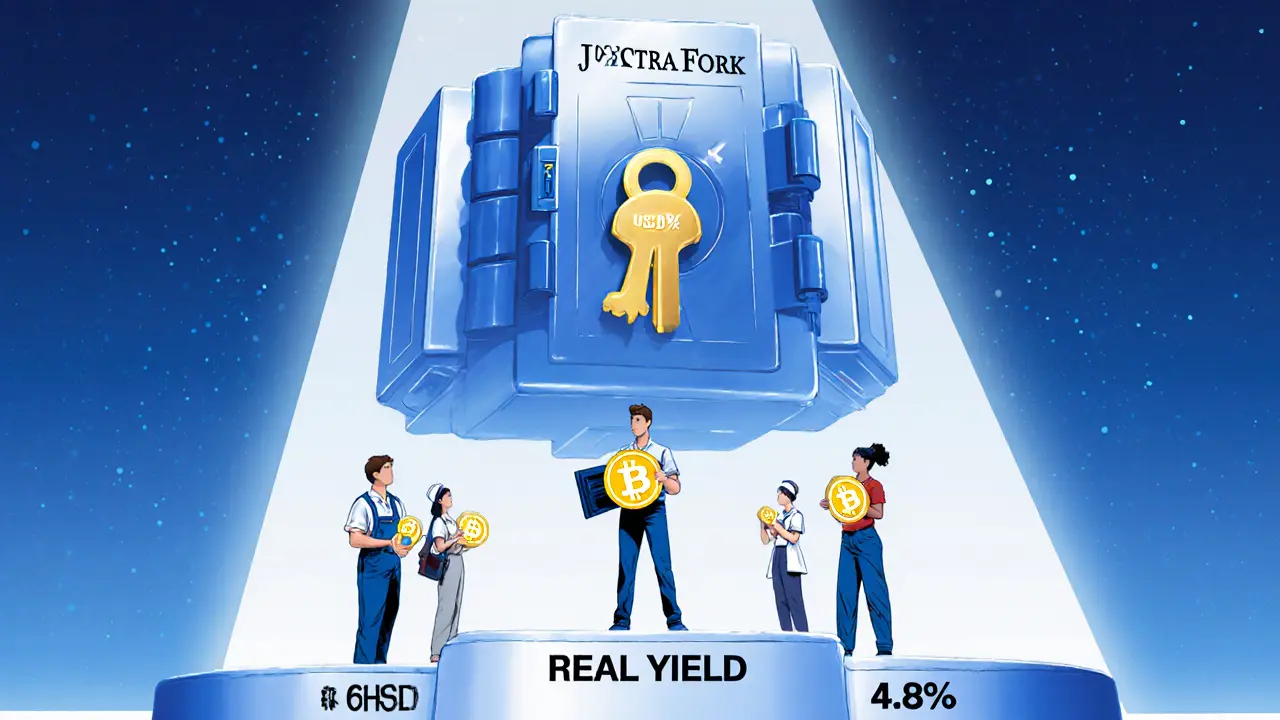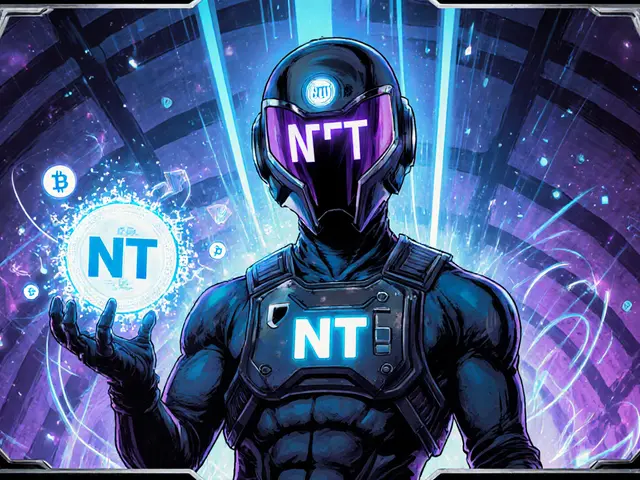How to Earn Passive Income with DeFi in 2025: Real Strategies, Risks, and Returns
DeFi Yield Calculator
Calculate Your Potential Returns
Estimate realistic passive income based on current DeFi market conditions. All calculations reflect 2025 market data from the article.
Your Investment
Results
Your estimated annual returns will appear here after calculation.
Important Considerations
Based on article data: Stablecoin lending typically yields 2.3-4.8% APY, while liquidity provision can reach 5-15% but with higher risk.
Most people think passive income means sitting back and watching money grow-like dividends from stocks or rent from property. But in DeFi, passive income isn’t as simple as clicking a button and waiting. It’s more like running a small financial business on the blockchain: you’re lending, locking, or supplying assets, and you get paid for it. The returns can be tempting-sometimes 5%, 10%, even 20% a year-but so are the risks. By 2025, the DeFi space has matured. The wild, 100% APY farms are mostly gone. What’s left are real, measurable ways to earn, if you know where to look and what to avoid.
What DeFi Passive Income Actually Means
DeFi stands for decentralized finance. It’s financial services-lending, borrowing, trading, earning interest-built on blockchains without banks or brokers. When you earn passive income in DeFi, you’re not working. You’re not trading. You’re simply holding crypto in a smart contract, and that contract pays you for letting others use your assets.
Think of it like renting out your car. You’re not driving it. You’re not cleaning it. But someone else uses it, and you get paid. In DeFi, you’re renting out your ETH, USDC, or DAI. The smart contract matches you with borrowers or traders, and you earn a cut. The key difference from traditional finance? You control your money. No bank freezes your account. No middleman takes 30% of your interest. But also, no FDIC insurance. If the code breaks, you lose it.
As of January 2025, over $112 billion was locked in DeFi protocols. That’s up nearly 30% from the year before. People aren’t just speculating anymore-they’re using DeFi to generate real, ongoing income.
Four Main Ways to Earn Passive Income in DeFi
There are four primary methods to earn passive income in DeFi. Each has different risk levels, technical requirements, and potential returns.
- Staking - Locking up coins like Ethereum, Solana, or Polygon to help secure the network. In return, you earn new coins as rewards. Ethereum staking pays around 3.5-4.5% APY. You can stake directly (need 32 ETH), through a pool like Lido (minimum 0.001 ETH), or via exchanges like Coinbase (3.2-4.5% APY).
- Lending - Depositing crypto into protocols like Aave or Compound. Borrowers take out loans using your assets as collateral, and you earn interest. USDC on Compound paid 4.8% APY in February 2025. DAI paid 2.3%. The rate changes based on demand.
- Liquidity Provision (Yield Farming) - Supplying pairs of tokens (like ETH/USDC) to decentralized exchanges such as Uniswap or Curve. You earn trading fees and sometimes bonus tokens. APYs can be high-sometimes over 10%-but you also risk impermanent loss if the token prices move sharply.
- Dividend Tokens - Holding tokens like KuCoin Token (KCS) or VeChain (VET) that automatically distribute a portion of platform fees to holders. KCS pays out 50% of exchange trading fees monthly. VET generates VTHO tokens daily at a fixed rate.
Here’s how they compare in 2025:
| Method | Typical APY | Difficulty | Risk Level | Best For |
|---|---|---|---|---|
| Exchange Staking (e.g., Coinbase) | 3.2-5.0% | Very Easy | Medium | Beginners |
| Native Staking (Ethereum) | 3.5-4.5% | Easy | Low | Tech-savvy users |
| Stablecoin Lending (Aave/Compound) | 2.3-4.8% | Medium | Medium | Conservative earners |
| Liquidity Provision (Uniswap v3) | 5-15% (can spike higher) | Medium to Hard | High | Experienced users |
| Dividend Tokens (KCS, VET) | 3-7% | Very Easy | Medium | Low-effort holders |
Real Risks You Can’t Ignore
It’s easy to get excited about 12% APY. But DeFi is not a bank. You’re dealing with code, not contracts.
Impermanent loss is the biggest trap for new liquidity providers. Say you put $1,000 in ETH/USDC pool. ETH rises 20% in a week. Your share of the pool gets rebalanced to match the new price ratio. When you withdraw, you end up with less ETH than you started with-even if the token price went up. One Reddit user reported a 12.3% impermanent loss on a stablecoin pool during ETH volatility, cutting his 18.7% APY down to just 6.4% net.
Smart contract exploits happen. In January 2025, a Curve Finance pool lost $3.8 million because an oracle fed fake price data. Over $2.3 billion has been lost to DeFi hacks since 2020. Most aren’t due to broken cryptography-they’re because the code logic was flawed. As Cornell professor Dr. Elaine Shi says, “83% of DeFi exploits come from logic errors, not hacking.”
Token emissions are another illusion. Many high-yield farms pay you in their own tokens. If those tokens crash (and many do), your “100% APY” turns into a $100 loss. A 2024 UC Berkeley study found 61% of top yield farms saw token prices drop faster than the rewards added up.
And then there’s regulation. In January 2025, Coinbase shut down its high-yield USDC product after SEC pressure. Now they offer only 5% APY-but capped at $10,000 per user. If you’re earning from a protocol that’s not compliant, it could disappear overnight.

How to Start (Step by Step)
You don’t need to be a coder to start. But you do need to be careful.
- Get a non-custodial wallet - Use MetaMask or Trust Wallet. Never use an exchange wallet for DeFi. You need full control.
- Buy ETH, MATIC, or BNB for gas - You’ll need $50-$100 worth of gas tokens to interact with most protocols. Ethereum mainnet fees can spike to $50+ during busy times. Consider using Layer 2s like Arbitrum or Optimism-they’re 90% cheaper.
- Buy your first stablecoin - Start with USDC or DAI. They’re stable, widely accepted, and less risky than volatile tokens.
- Choose your first method - For beginners: stake USDC on Coinbase or lend it on Aave. Both are simple, audited, and have insurance coverage.
- Check for audits and insurance - Look for protocols audited by CertiK, OpenZeppelin, or Trail of Bits. Over 67% of DeFi TVL is now protected by insurance from Nexus Mutual or InsurAce.
- Track your real yield - Use Dune Analytics dashboards. Advertised APYs often don’t include gas fees or token price drops. One user on Reddit found his “15% APY” farm was actually netting 2.1% after fees and slippage.
A 2025 CoinGecko study found beginners spend 20-40 hours learning before making their first move. Don’t rush. Watch YouTube tutorials. Read protocol docs. Join Discord servers. The community is active-but you need to ask the right questions.
What’s Changed in 2025
DeFi isn’t the wild west anymore. It’s getting serious.
One big update: Ethereum’s Pectra hard fork in March 2025 cut staking withdrawal times from 48 hours to just 4-8 hours. That means you’re no longer locked in for days if you need cash. It’s a huge improvement for liquidity.
Another shift: “Real yield” is replacing “fake yield.” In 2023, most high APYs came from new token emissions. Today, protocols like Pendle Finance generate 87% of their yields from actual revenue-fees from trading, lending, or options. That’s sustainable. That’s real.
Even institutions are in. JPMorgan launched its own DeFi staking product for clients in February 2025, offering 4.2% APY on USDC with FDIC-insured principal. That’s not a joke anymore. This is finance, now on blockchain.

Who Should Avoid DeFi Passive Income?
DeFi isn’t for everyone.
If you don’t understand what a wallet is, or you think “staking” means buying a crypto coin and forgetting about it-you’re not ready. If you’re chasing 50% APYs because you saw a TikTok video, you’re likely to lose money. If you’re using borrowed funds or putting in your rent money-don’t. DeFi is high-risk by nature. Even the safest options carry smart contract risk.
And if you’re in a country where DeFi is banned or heavily restricted (like the U.S. under current SEC enforcement), you’re playing with fire. Some protocols have already shut down for U.S. users. Don’t use a VPN to bypass rules. The legal risk isn’t worth the APY.
Final Thoughts: Realistic Expectations
Can you earn $42,000 a year from $500,000 in DeFi? Yes. One user on the Bankless podcast did it. But that took years of learning, diversification across 12 protocols, constant monitoring, and risk management. It’s not passive-it’s active management with automation.
For most people, a better goal is 4-6% annual return on stablecoins, safely. That’s higher than any savings account. It’s real. It’s accessible. And it doesn’t require you to become a blockchain expert.
DeFi passive income isn’t about getting rich quick. It’s about using your crypto more wisely. If you treat it like a side business-with research, discipline, and caution-you can build steady returns without gambling.
Start small. Learn slowly. Protect your assets. And never chase yield without understanding the risk.
Can you really earn passive income with DeFi without losing money?
Yes-but only if you avoid high-risk strategies. Stablecoin lending and exchange staking have proven track records with low to medium risk. You can earn 3-5% APY safely. But yield farming, high-APY token farms, and leveraged positions carry high risk of loss. Most people who lose money in DeFi do so by chasing unrealistic returns without understanding impermanent loss or smart contract risk.
Is DeFi passive income better than bank interest?
In terms of returns, yes-by a lot. Bank savings accounts pay under 1% in 2025. DeFi stablecoin yields range from 2-5%. But there’s a trade-off: banks are insured. DeFi isn’t. If a protocol gets hacked or the code fails, you lose your funds. So it’s higher return for higher risk. If you’re comfortable managing your own digital assets and understand the risks, DeFi is a better option. If you want safety above all, stick with a bank.
Do I need to be tech-savvy to start?
You don’t need to be a developer, but you do need to understand basic crypto concepts: wallets, gas fees, private keys, and how to connect your wallet to a dApp. Most beginners spend 20-40 hours learning before making their first transaction. Platforms like Coinbase and Aave have simplified interfaces, but you still need to know what you’re doing. If you’re uncomfortable with the idea of losing funds due to a typo or wrong network, wait until you’re ready.
What’s the safest way to start earning in DeFi?
The safest way is to stake or lend stablecoins through a regulated exchange like Coinbase or Kraken. Their USDC staking offers 5% APY with institutional-grade security. Alternatively, lend USDC on Aave or Compound-both have been audited for years and have insurance coverage. Avoid anything with APY over 10% unless you’ve researched the protocol deeply. Start with $100-$500. Learn the process. Then scale.
Are DeFi yields sustainable long-term?
The high-yield “free money” era is over. In 2023, many DeFi protocols paid 20-50% APY by flooding the market with new tokens. That’s not sustainable-it just diluted value. In 2025, yields have stabilized. Stablecoin APYs are now around 4-5%. The trend is toward “real yield”-income from actual fees and usage, not token emissions. This is more sustainable. Institutional adoption (like JPMorgan’s product) also adds legitimacy. Long-term, expect 3-6% APY as the new normal.
Can I lose my crypto in DeFi?
Yes, and you can lose it all. Unlike banks, DeFi has no safety net. If you send funds to the wrong address, they’re gone. If a smart contract is exploited, your money can be drained. If you approve a malicious token, hackers can steal your entire wallet balance. Always double-check contracts. Use small amounts first. Never connect your wallet to sites you don’t trust. And never share your private key-not even with “support.”
What’s the difference between staking and lending in DeFi?
Staking means locking your crypto to help secure a blockchain network (like Ethereum). You earn new tokens as rewards. Lending means giving your crypto to others who borrow it. You earn interest paid in the same token you lent. Staking is tied to consensus mechanisms; lending is tied to supply and demand. Staking usually has lower risk but lower returns. Lending can have higher returns but carries borrower default risk (though most loans are overcollateralized).
Do I pay taxes on DeFi passive income?
Yes. In most countries, including the U.S., Canada, and Australia, interest earned in DeFi is taxable as income. Every time you receive tokens as rewards, it’s a taxable event based on their value at that moment. Even if you don’t sell them, you still owe tax. Use crypto tax software like Koinly or TokenTax to track it. Ignoring this can lead to penalties.








DeFi isn't magic. It's math with risk. I started with $200 in USDC on Aave and made $8 last month. Not life-changing, but better than my bank. No drama, no hype. Just steady.
Staking on Coinbase? That’s fine. But you’re giving up control. And if they freeze your account? You’re out. No recourse. No FDIC. No nothing. You’re trusting a corporation. That’s not decentralized.
People treat DeFi like a slot machine. But it’s not about returns. It’s about sovereignty. When you hold your own keys, you’re not just earning interest-you’re rejecting the old system. That’s the real yield.
They say JPMorgan’s in DeFi? Yeah, right. That’s a trap. They’re not here to help you-they’re here to monitor you. Every transaction gets logged. Every wallet gets flagged. They’ll shut it down the second you try to move more than $10k. This isn’t finance. It’s surveillance with a blockchain sticker.
For those of us in developing economies, DeFi is the first real financial tool we’ve ever had. No bank approval. No minimum balance. No hidden fees. I earn more on DAI than my salary in rupees. It’s not perfect. But it’s fairer than what came before.
just started with 50 usdc on coinbase. 5% is better than 0.1% in my savings account. no stress. no drama. just chill.
in India we can’t use most DeFi apps. But I use a friend’s US account to stake USDC. Is it risky? Yes. But my savings account gives me less than 3% and inflation is 6%. I’d rather lose $50 than lose 6% every year.
Impermanent loss is a myth. It’s just a euphemism for 'you lost money.' If you don’t understand that liquidity pools are volatile, you shouldn’t be here. Stop pretending it’s passive. It’s not. It’s gambling with math.
Have you seen the latest Curve exploit? $3.8 million gone in 12 minutes. And people still say 'it’s just code'? Code doesn’t lie-but humans who write it? Oh, they lie. Every. Single. Time. I’ve watched 17 protocols die since 2022. The 'real yield' is just a marketing buzzword for 'we ran out of money to pay you.' Don’t be fooled.
Oh so now we’re supposed to be impressed that JPMorgan is 'in DeFi'? That’s like saying the mafia opened a lemonade stand and called it 'community finance.' You think they care about your 4.2% APY? They care about your data. Your wallet. Your habits. This isn’t innovation. It’s colonization.
I’ve been in DeFi for three years. Started with $500. Lost $120 on a bad farm. Made $300 on stablecoin lending. Now I keep 80% in USDC on Aave. 4.5% is boring. But it’s mine. No one can take it. No one can freeze it. That’s worth more than any APY number.
Why are we even talking about this? The entire system is rigged. The Fed prints money. The banks get bailed out. Now they want to control DeFi too? They’ll tax you, regulate you, shut you down. This isn’t freedom-it’s the next phase of control. You think you’re winning? You’re being groomed.
Just did my first stake on Lido. 4.2% APY. Took 10 minutes. No headaches. I used my phone. No fancy wallet. No gas fees. Just tap and go. If this is the future? I’m in. 🤝
For anyone new: start with USDC on Aave. Read the audit report. Don’t skip it. Check the TVL. Look at the governance votes. If it’s been stable for 6+ months? You’re probably safe. Don’t chase yield. Chase reliability.
DeFi is the future. But only if you’re willing to fight for it. The banks don’t want you to know this. The government doesn’t want you to control your money. That’s why they’re coming for you. They’ll ban it. They’ll tax it. They’ll lie to you. But if you’re awake? You’ll keep going. Because freedom isn’t free. It’s earned with knowledge.
Anyone who claims DeFi is 'passive income' is either lying or profoundly uninformed. You are managing risk. You are monitoring contracts. You are tracking gas fees. You are auditing protocols. You are not sitting back. You are working. The term 'passive' is a dangerous misnomer. Do not be misled.
cool. thanks for the info.
Start small. Learn one thing at a time. Your first goal isn’t to make money. It’s to not lose it. I taught my mom how to stake USDC on Coinbase. She didn’t understand smart contracts. But she knew 5% was better than 0.1%. That’s all that matters.